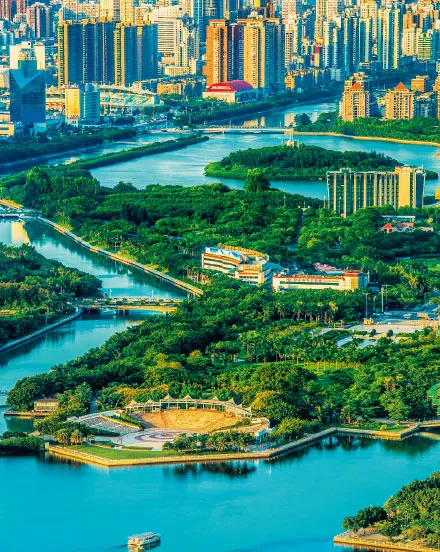Yundang Lake Gets Epic Facelift
By staff reporter XIA YUANYUAN
The transformation of Yundang Lake from a stinky lake to an urban reception hall has made it a showcase of ecologival restoration in China.

A full view of the Yundang Lake.Photo courtesy of Lu Changyi
BEFORE settling down in the City of Xiamen,Scott Patrick and his wife spent long hours searching online for just the right part of the city.When they saw Yundang Lake in west Xiamen,the couple knew they had hit the jackpot.
“The picture of the beautiful lake circled by lush vegetation caught our attention.We knew this was the place we were looking for,” said Patrick.Later,after setting foot in Xiamen,he told himself he had definitely made the right life decision.
At present,Patrick works at the Xiamen International School as a music teacher.The couple have now lived in this coastal metropolis for over two years and roaming the Yundang lakeside area,watching egrets flying over calm,clean water has become part of their daily routine.
As the only artificial lake in Xiamen,Yundang Lake has a water area of 1.6 square kilometers.Flowing across the city and linking up with the ocean,it makes Xiamen “a city on the sea.” However,Patrick would recoil in horror if he had seen the state of the lake three decades ago.
In the 1970s,the raw domestic sewage of hundreds of thousands of residents nearby together with industrial wastewater of over 300 manufacturing plants was dumped directly into the lake.As a result,Yundang Lake became an overgrown cesspool cluttered with trash.
From the 1980s,the local municipal government began to control the pollution of the lake.After the implementation of a four-phase comprehensive plan that covered a span of 30 years,the lake has gradually been transformed.The vast expanse of clear water has benefited directly from Xiamen’s ecological construction.

Locals enjoy leisure time during weekends with their families on the picturesque Yundang lakeside.
After the implementation of a four-phase comprehensive plan that covered a span of 30 years,the lake has gradually been transformed.
Once a Smelly Gutter
Fu Xunyi,a senior engineer from the Yundang Lake Protection Center in Xiamen,is a local who grew up near the lake.
“In the past,we called it a smelly gutter,” he recalled.
Yundang Lake was known as Yundang Port in the past.Situated in the west of Xiamen Island,it was previously linked to the sea,and was therefore used as a home port.In the 1970s,in order to reclaim land from the sea,a dyke from Fuyu to Dongdu was built.As a result,the previous Yundang Port became a closed artificial lagoon,which became Yundang Lake.The lake gradually became stagnant,and with the building of factories around it,large quantities of industrial wastewater and sewage were then dumped into the lake.
“In spring and summer,the weeds ran riot,and litter was dropped everywhere.The lake stank,and fish,shrimps,and egrets disappeared.Residents living nearby suffered a lot,” said Fu.
From the mid-1980s on,to treat the heavy pollution in the lake,the Xiamen municipal government decided on a plan to ban illegal discharge,desilt the lake,build embankments,make the water flow again,and beautify the surroundings.It would be a long-term plan,but the local authorities were determined to solve the problem even if it took several terms of government administrators.
“To get rid of the heavy stench in the lake,the first step was to control the source of the pollution,” said Fu.In order to cut off pollution,the municipal government shut down and relocated over 100 polluting enterprises along with 14 major polluters nearby.Meanwhile,the construction of sewage treatment plants was begun,and projects to intercept pollutants from being discharged into the lake were also carried out.
In order to remove pollutants that had been deposited for years,large-scale desilting was carried out by the government.The silt,after treatment,was used to build banks and an island in the lake center.This not only improved the water quality of the lake,but also greatly enhanced its flood control capabilities.
In addition,in order to bring the lake water “to life,” the local government innovatively utilized changes in the tide to connect the lake with the sea.They built floodgates on the dykes,which receive water at high tide and drain water at low tide,effectively enhancing the overall flood control and water exchange capacity of the lake area.
In order to restore the ecosystem of the lake area,since 1999,mangroves were planted there as an experiment to improve the local landscape.Today,Yundang Lake is surrounded with lush green vegetation,the marine ecosystem has been restored,and waterfowls are enjoying the environment.
Data from the Yundang Lake Protection Center show that the water quality has improved significantly,with the concentration of ammonia nitrogen having plummeted from 39.4 milligrams per liter in 1987 to 0.076 milligrams per liter in 2022;and that a total of 63 species of nektons,123 phytoplanktons,73 zooplanktons,and 14 benthons have been discovered in the lake area.A total of 95 species of birds have also been observed.The lake attracts migratory birds such as cormorants to overwinter each year.
The pristine,peaceful environment has become a magnet for tourists and the Yundang Lake area is now an “urban green lung” of Xiamen City.
A Tough Ecological Battle
The mangrove forests along the lakeside attract flocks of egrets that often perch on branches,play and forage,hover,or frolic around,forming a picture of harmonious coexistence between humans and nature.
Mangroves are a woody plant community that live in the intertidal zone of tropical and subtropical coastal zones,with the ability to absorb pollutants in water.They play an important role in improving the aquatic ecosystem of the lake area,storing up carbon,and maintaining biodiversity.That’s why they are called the “green lungs of the ocean” and“coastal guardians.”
The pristine,peaceful environment has become a magnet for tourists and the Yundang Lake area is now an “urban green lung” of Xiamen City.
In fact,mangroves are no strangers to Yundang Lake.They were once planted around the lake but later disappeared due to land reclamation from the sea.
In order to restore the ecosystem of the lake area,in 1999,the lake administration office,predecessor of the Yundang Lake Protection Center,and Professor Lu Changyi’s team from College of the Environment and Ecology in Xiamen University,began an experiment of growing mangroves along the lake.
“Mangroves live in mudflats that are located at a certain altitude.At the beginning,the area in Yundang Lake selected to grow mangroves was too low,and needed to be filled with mud to elevate it,” said Professor Lu.At that time,according to him,because the amount of sea mud near the embankment was insufficient,they had to transport mud from farther inside the lake to the mudflat by barge.Workers then spread the thick mud in knee deep and waist deep water—a major task.
From 2001 to date,the restoration took over 20 years.“Over 2,000 people have been involved in the huge project,especially employees from the Yundang Lake Protection Center.Without their cooperation and persistence,the planting area of 26,000 square meters would have been unimaginable,” said Lu.At present,the total planting area of mangroves across Xiamen City adds up to five million square meters.
At present,the lake has been greatly optimized ecologically,especially after the planting of different varieties of mangroves such as kandelia,avicennia marina,and rhizophora stylosa.The goal of fixing the embankment and landscape improvement has been achieved,as evidenced by the thriving birdlife.
“After the number of egrets increased here,this islet in the lake center was renamed Egret Island,” said Lu.
The transformation from “a stinky lake” to “an urban reception hall” has made the comprehensive management of Yundang Lake a prime example of ecological restoration in China.As a result,in 1993,it was rated by the United Nations Development Programme as a demonstration project for pollution prevention and management in the sea area of East Asia.

